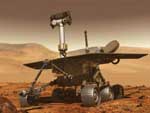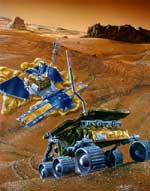Pathfinder's 5th Anniversary Reveals Big Future for Mars Exp
by Jet Propulsion Lab (JPL)
More articles in MissionsOn Friday, July 4, 1997, American flags dressed the nation in a giant Independence Day celebration. It was National Hot Dog Month, and an estimated 155 million hot dogs hit the grill that weekend alone. Space must have been on moviegoers minds, as the alien flick "Men in Black" took in a whopping $84 million during its holiday opening. How appropriate then that 192 million kilometers (119 million miles) away from Earth, there was even more to celebrate: NASA's Mars Pathfinder mission had completed its seven-month journey by bouncing to a landing on Mars and opening up a whole new world of Mars exploration. The landing was a tremendous event at JPL, where mission controllers cheered, clapped and even shed tears over their success.
 Sojourner rover deployed on Mars
Sojourner rover deployed on Mars Now known as the Sagan Memorial Station, the Mars Pathfinder lander, along with the moving vehicle Sojourner, brought Americans together to share new and exciting information about our mysterious neighboring planet. Initially sent to demonstrate new and inexpensive technology, the spacecraft ended up literally "finding a path" for a parade of Mars missions that will follow in the next decade.
Making a Big Entrance
“The dominant thing that Pathfinder was about was an entry, descent and landing demonstration and a development of technology that could be used,” said Mars Pathfinder Project Scientist Matt Golombek. “That’s really come through here, now, in everything, so that’s the big deal.”
 Pathfinder, as seen by Sojourner Rover on Mars
Pathfinder, as seen by Sojourner Rover on Mars Pathfinder’s robust, inexpensive airbag landing system used a ballistic approach to land on Mars. Without orbiting first, the space probe directly entered Mars’ atmosphere and landed. In 2003, when the first of two Mars Exploration Rovers makes the same journey, it will be equipped with an updated version of this revolutionary landing mechanism. Instead of deflating upon initial impact like a car’s airbag system would, the spacecraft’s sealed airbags stay inflated for every hit. They then bounce about 1 kilometer (.62 miles) across Mars’ rocky surface like a superball in slow motion, eventually losing energy through friction.
Engineers have changed a lot about the landing system for the Mars Exploration Rover, but the overall architecture is basically the same. The new lander is about 150 kilograms (402 pounds) heavier than Pathfinder’s, and its slightly larger structure allows for a bigger rover. The airbags now have more abrasion resistance and additional layers. Still, even though the landing system was successful on Pathfinder, it isn’t guaranteed a repeat performance.
“The more we learn about Mars, the harder it seems to get there because Mars is not as safe as we once thought,” said Rob Manning, spacecraft chief engineer for Mars Pathfinder and spacecraft systems engineering manager for the Mars Exploration Rover. “We can, however, stack the odds very much in our favor.”
Accommodating the Chicken and the Egg
Imagine designing a vehicle that could land anywhere in the United States. From beaches and prairies to hills and mountains, the terrain and conditions would be so diverse that the vehicle would have to handle as much variety as possible. That variety is also present on Mars. Without orbiters like Odyssey and the Mars Global Surveyor to take pictures of Mars' terrain, engineers and scientists would have little to go on.
 Artist's concept of Mars Exploration Rover
Artist's concept of Mars Exploration Rover "Pathfinder was the first mission to accurately predict what the landing site was going to be like before getting down to the surface of the planet," Golombek said. However, engineers did not know what conditions the Pathfinder rover would encounter on Mars before they designed the vehicle to survive at least a week of safe roving.
"It's kind of like the chicken-and-the-egg problem," Manning said. "We are trying to learn about what Mars is like by sending missions there, but the missions need to know what Mars is like to go there."
Manning likened the evolution of design for Mars spacecraft to that of bicycles in the late 1800s. "There was a lot of variety back then because they hadn't figured it out yet. Bicycles today look very different than they did back then because we continued to develop them. Vehicles of the future are going to look very different than they do today because we often have to discover what we build as we build it. It's a race between what we learn about the technologies we develop and what we learn about Mars."
Since Pathfinder, engineers have added more intelligence to the spacecraft and more control as the vehicle approaches landing. They have also obtained a better simulation of how winds develop and flow on Mars, as well as a better understanding for how those winds affect a safe landing. This benefits them when picking a landing site, but it limits where and how high they can go.
Sharing the Goods
Since no orbiters operated around Mars during the Pathfinder mission, Pathfinder was unable to transmit information via orbiter back to Earth. Instead, the Sojourner rover used the Pathfinder lander as a middleman to communicate with Earth. This meant that the rover had to stay close to the lander at all times. Unfortunately, this presented limitations not only in the amount of ground scientists could explore, but also in the amount of information they could receive in one day. Sending and receiving information through the lander's direct-to-Earth link (an antenna pointed toward Earth) used up a lot of energy, and the rover's battery had to be saved to keep warm in Mars temperatures, which varied by 38 degrees Celsius (100 degrees Fahrenheit) per Mars day.
 Artist's concept of Sojourner rover on Mars
Artist's concept of Sojourner rover on Mars Scientists and engineers have learned from this, and as a result, have given the Mars Exploration Rover the ability to communicate directly with Earth. The disadvantage here is that images of the rover from the lander will be unavailable; however, the Mars Exploration Rover will have more ways to send information back to Earth. Critical data like spacecraft health and basic information on findings can travel through a direct-to-Earth link like the one used on Pathfinder. Extraneous images and other non-critical data can travel through the close-by Odyssey orbiter, which transmits information to Earth in a matter of minutes.
Serving up the Science
"Pathfinder started the thread of continuity between science, water, climate and life, and the Mars Exploration Rover will continue it, for sure," said Golombek, who is also a science team member on Mars Exploration Rover.
Following up on Pathfinder's glimpse of Mars, the Mars Exploration Rover will move further and do more to learn about the planet's history, water cycle and climate. Pathfinder's discoveries, combined with images from orbiters and the raging debate among scientists about life on Mars, has in some sense sparked a renaissance in Mars exploration.
"It has changed the way scientists work with Mars and the way scientists work together," Manning said. "Scientists of different disciplines now collaborate to solve complicated problems and to understand how life and natural history complement each other."
Mars has been opening secrets very slowly with tantalizing excitement, such as the most recent Odyssey discovery of water. Before Pathfinder launched, scientists had enough evidence to predict water just below the surface of Mars, but the discovery was still surprising.
"The evidence of water on Mars is ubiquitous," Manning said. "The big question is where did it all go? It couldn't have all evaporated. We know there is a big correlation between water and the evolution of life on this planet, so we have lots of hope that there may be signs of early life on Mars."
Golombek speculated that in 2005 or 2009, we might investigate rocks and water on Mars. We may even know whether pre-biotic chemistry existed on the red planet. At the very least, with the Mars Exploration Rover, we will learn a lot about Mars' very complicated history and how it became the way that it is now.
"You must crawl first, then walk." Golombek said. "Pathfinder was the first baby step, Mars Exploration Rover is going to take the next big step, and we're hoping for more steps beyond that."